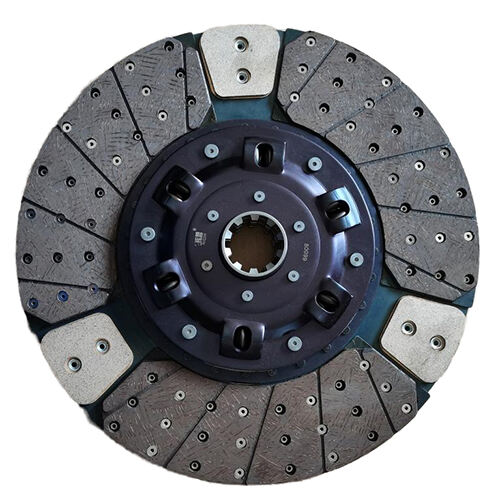The process of selecting an appropriate clutch pressure plate for production operations proves challenging for most companies today. Multiple solution choices require businesses to learn about their distinctions while recognizing their specific advantages. This guide will present all crucial factors you need to think about to help you make a well-informed choice.
The foundation of clutch pressure plates must be grasped before making decisions
A clutch pressure plate functions as an essential system component which controls the engine power delivery to transmission. The system containing these components enables the transmission of power through clutch disc operation with the support of the release bearing to enable smooth gear shifting in vehicles. The three major categories of clutch pressure plates consist of diaphragm style and finger-type plates with dual-mass as the third option. Every clutch pressure plate design possesses various specifications which determine their specific use cases in vehicle systems.
Evaluating Your Production Requirements
You must perform a requirement assessment of your production conditions before moving ahead to study the different pressure plate types.
Vehicle Type and Usage: Assessment of vehicle uses and types needs attention since it directly impacts the production requirements. Different pressure plates exist for heavy-duty trucks independent of passenger cars and performance vehicles.
Performance Needs: The necessary performance specifications include torque capacity together with responsiveness and durability levels.
Production Volume: Factor in the production scale. Diverse manufacturing requirements between big-scale assembly and customized minimum-run operations require separate attention.
Budget Constraints: Select a product which matches your budget restrictions but maintains first-rate performance standards.
Diaphragm Pressure Plates
Diaphragm pressure plates represent the dominant selection among different options because they operate effortlessly and maintain reliable functionality. A conical diaphragm spring works as a mechanism to press the clutch disc inside diaphragm pressure plates.
Key Advantages
Smooth Engagement: Door-to-Door gear shifts become more comfortable because diaphragm plates disperse pressure equally across the system.
Maintenance: Diaphragm pressure plates need very little upkeep making them an optimal solution for normal consumer vehicles.
Cost-Effective: The basic design of diaphragm pressure plates allows manufacturers to produce them at lower costs when compared to other options.
Applications
Diaphragm pressure plates function as an excellent fit for passenger cars but also work for light trucks together with performance vehicles. Cost-effective performance characteristics of these pressure plates makes them the preferred selection for multiple production lines.
Finger-Type Pressure Plates
Yichun Marke pressure plates together with their alternative name coil spring pressure plates function by using coil springs and levers for pressure application. This device stands out because of its powerful operational capabilities along with strong resistance to damage.
Key Advantages
High Torque Capacity: The above pressure plates excel at managing greater torque which perfectly suits demanding high-performance and heavy-duty operational requirements.
Durability: This system offers long-lasting durability because of its durable build design.
Customizability: The number and strength of incorporated springs allows end-users to customize these devices for particular performance conditions.
Applications
The pressure plates with fingers find applications in heavy-duty trucks, racing vehicles and various other high-performance vehicle systems. These components maintain essential usage in high-torque applications because of their powerful functionality.
Dual-Mass Pressure Plates
Dual-mass pressure plates optimize operation by effectively damping vibrations with their dual-mass flywheel configuration.
Key Advantages
Vibration Reduction: The plates serve to substantially decrease vibrations while minimizing noise levels to provide better driving comfort.
Longevity: Acceptable vibration reduction leads to extended survival for drivetrain parts.
Performance: The performance quality of these items remains exceptional for premium-class cars that prioritize smooth rides.
Applications
Premium passenger cars together with light trucks need dual-mass pressure plates in order to achieve maximum comfort with minimal noise production. These pressure plates typically appear in cars that belong to luxury brand categories together with high-performance sports vehicles.
Making the Final Decision
Pressures from clutch performance must be combined with product costs and vehicle requirements during pressure plate selection. A proper evaluation process should begin by examining all vehicle types combined with their torque requirements and planned production rates. Analysis with financial limitations should consider long-term expenses from repairs and components replacements when reducing costs.
The diaphragm pressure plate stands as the preferred option for most standard consumer vehicles that need the perfect combination of performance.
The finger-type pressure plate stands out as the best choice for applications demanding heavy-duty capabilities.
Premium comfort along with refined driving experiences can only be achieved through dual-mass pressure plates.
The weighing process between these factors will help your production line function with efficiency and economic effectiveness. Knowledge of specialized clutch pressure plate advantages and usage domains enables you to select equipment that meets your manufacturing needs while assuring client quality consistency.
The article presents a thorough introduction to selecting appropriate clutch pressure plates for diverse manufacturing scenarios with coverage of general descriptions and different categories and installation examples and important decision-making criteria.

 EN
EN AR
AR
 BG
BG
 HR
HR
 CS
CS
 DA
DA
 NL
NL
 FI
FI
 FR
FR
 DE
DE
 EL
EL
 HI
HI
 IT
IT
 JA
JA
 KO
KO
 NO
NO
 PL
PL
 PT
PT
 RO
RO
 RU
RU
 ES
ES
 SV
SV
 CA
CA
 TL
TL
 ID
ID
 LV
LV
 LT
LT
 SR
SR
 UK
UK
 VI
VI
 HU
HU
 TH
TH
 TR
TR
 FA
FA
 AF
AF
 MS
MS
 SW
SW
 GA
GA
 HY
HY
 KK
KK
